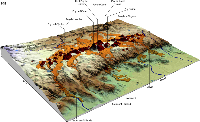Testing a geographical information system for damage and evacuation assessment during an effusive volcanic crisis
Latutrie B., I. Andreakis, T. De Groeve, A. J. L. Harris, E. Langlois, B. Van Wyk De Vries, E. Saubin, G. Bilotta, A. Cappello, G. M. Cridci, D. D’Ambrosio, C. Del Negro, M. Favalli, E. Fujita, G. Iovine, K. Kelfoun, R. Rongo, W. Spataro, S. Tarquini, D. Coppola, G. Ganci, F. Marchese, N. Pergola & V. Tramutoli (2015).
Geological Society, London, Special Publications, 426, http://doi.org/10.1144/SP426.19
Abstract
Using two hypothetical effusive events in the Chaîne des Puys (Auvergne, France), we tested two geographical information systems (GISs) set up to allow loss assessment during an effusive crisis. The first was a local system that drew on all immediately available data for population, land use, communications, utility and building type. The second was an experimental add-on to the Global Disaster Alert and Coordination System (GDACS) global warning system maintained by the Joint Research Centre (JRC) that draws information from open-access global data. After defining lava-flow model source terms (vent location, effusion rate, lava chemistry, temperature, crystallinity and vesicularity), we ran all available lava-flow emplacement models to produce a projection for the likelihood of impact for all pixels within the GIS. Next, inundation maps and damage reports for impacted zones were produced, with those produced by both the local system and by GDACS being in good agreement. The exercise identified several shortcomings of the systems, but also indicated that the generation of a GDACS-type global response system for effusive crises that uses rapid-response model projections for lava inundation driven by real-time satellite hotspot detection – and open-access datasets – is within the current capabilities of the community.
http://sp.lyellcollection.org/content/early/2015/11/05/SP426.19.abstract


